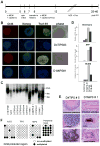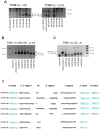Reprogramming of human peripheral blood cells to induced pluripotent stem cells
- PMID: 20621045
- PMCID: PMC2917234
- DOI: 10.1016/j.stem.2010.06.002
Reprogramming of human peripheral blood cells to induced pluripotent stem cells
Abstract
Direct reprogramming of human fibroblasts to induced pluripotent stem cells (iPS) has been achieved by ectopic expression of defined transcription factors. Derivation of human fibroblasts however is a time consuming process and requires punch biopsies or isolation of patient foreskin. Here we use a polycistronic vector encoding Oct4, Klf4, Sox2 and c-Myc to generate iPS cells from from frozen peripheral blood of several donors. Genomic DNA analyses indicated that iPS cells were derived from mature T cells as well as myeloid donor cells. Inducing pluripotency in peripheral blood would allow utilization of easy to get samples from the adult and, more importantly, provide convenient access to numerous patient samples stored in blood banks. The latter is of major interest as frozen blood samples, when reprogrammed to iPS cells, would allow the retrospective molecular analyses of rare diseases.
Figures


Comment in
-
Patient-specific pluripotent stem cells become even more accessible.Cell Stem Cell. 2010 Jul 2;7(1):1-2. doi: 10.1016/j.stem.2010.06.009. Cell Stem Cell. 2010. PMID: 20621038
References
-
- Davis MM, Bjorkman PJ. T-cell antigen receptor genes and T-cell recognition. Nature. 1988;334:395–402. - PubMed
-
- Evans MJ, Kaufman MH. Establishment in culture of pluripotential cells from mouse embryos. Nature. 1981;292:154–156. - PubMed
-
- Ferrante A, Thong YH. Optimal conditions for simultaneous purification of mononuclear and polymorphonuclear leucocytes from human blood by the Hypaque-Ficoll method. Journal of immunological methods. 1980;36:109–117. - PubMed
Publication types
MeSH terms
Grants and funding
LinkOut - more resources
Full Text Sources
Other Literature Sources

